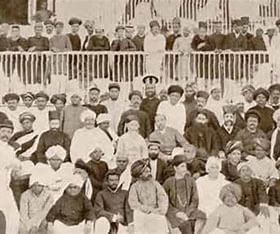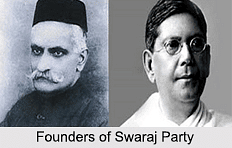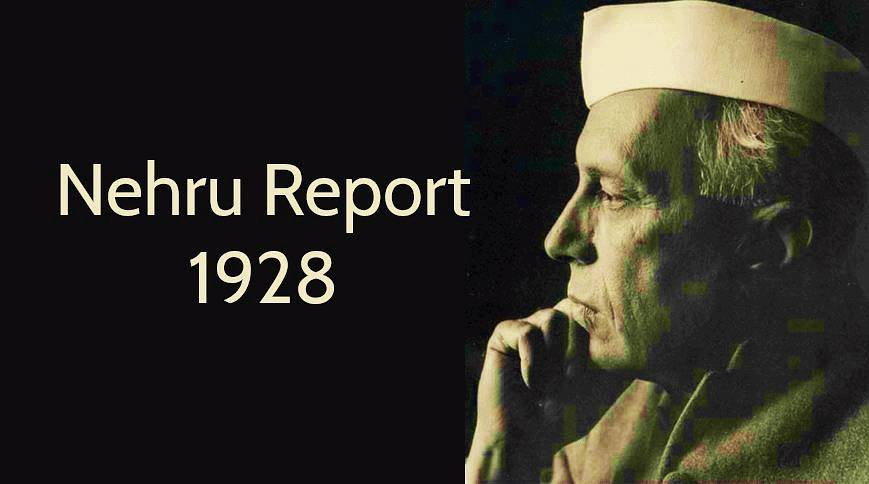Nationalist Movement Phase 2 (1915-1922) - 1 | History for UPSC CSE PDF Download
| Table of contents |

|
| Nagpur Session of Congress |

|
| Swaraj Party |

|
| Simon Commission |

|
| Nehru Report |

|
| Jinnah's Fourteen Points |

|
| Lahore Session |

|
Nagpur Session of Congress
The Nagpur session of the Indian National Congress held in December 1920 marked a pivotal moment in India's struggle for independence. Several significant changes were implemented, reshaping the organization, objectives, and methods of the Congress.

1. Redefinition of Congress Aim: The session reaffirmed the Congress's commitment to Swaraj, or self-rule, but with a nuanced understanding. Swaraj was now articulated as seeking "Self-Government within the Empire if possible and outside if necessary," reflecting a pragmatic approach to independence.
2. Evolution in Methods: The session witnessed a shift in the emphasis from solely relying on 'constitutional means' to embracing 'all peaceful and legitimate methods.' This broader approach acknowledged the diversity of tactics needed to achieve the goal of Swaraj.
3. Organizational Reforms
- Formation of Working Committee: A significant structural change was the establishment of a Working Committee comprising fifteen members. This committee was entrusted with acting as the chief executive body of the party, streamlining decision-making processes.
- Creation of All-India Committee: An All-India Committee consisting of 350 members was formed to deliberate on crucial issues. Serving as the apex body, it had the authority to review decisions and the functioning of the Working Committee, ensuring accountability and inclusivity.
- Strengthening Grassroots: Congress Committees were established at various levels, from towns to villages, facilitating broader participation and engagement with local communities. This decentralized structure aimed to mobilize support and disseminate Congress ideologies effectively.
- Linguistic Reorganization: Provincial Congress Committees were restructured along linguistic lines, aimed at promoting Congress ideals in local languages. Emphasis on Hindi aimed to bridge the gap between the educated elite and the masses, enhancing accessibility and resonance.
- Inclusive Membership: The session opened Congress membership to all men and women aged twenty-one or above, upon payment of a nominal annual subscription. This democratization of membership aimed to broaden the party's base and foster inclusivity.
4. Transition in Leadership: Following the demise of Bal Gangadhar Tilak in August 1920, leadership of the Congress transitioned into the hands of Mahatma Gandhi. This marked the onset of the Gandhian era in Indian politics, characterized by nonviolent resistance and mass mobilization.
5. Modernization of Organizational Structure: The Nagpur session propelled the Congress party towards modernization by adopting contemporary organizational practices. The establishment of local, regional, and national committees aligned with democratic principles and facilitated efficient functioning.
Swaraj Party
The emergence of the Swaraj Party, born out of the split within the Indian National Congress, marked a significant chapter in India's struggle for independence. Here's a breakdown of its key contributions and legacy:
1. Formation and Objectives
Background of Split: The suspension of the Non-Cooperation Movement led to divisions within the Congress, prompting leaders like Motilal Nehru and Chittaranjan Das to form a separate group known as the Swaraj Party on January 1, 1923.
Objective of Contesting Elections: The Swarajists aimed to contest legislative council elections and disrupt the colonial government from within. Led by figures like Motilal Nehru and C.R. Das, they advocated for participation in councils to expose government inefficiencies and push for reforms.
2. Electoral Success and Legislative Action
Impressive Electoral Gains: In the November 1923 elections, the Swaraj Party achieved notable successes, particularly in Bengal and the Central Legislative Council, with Motilal Nehru and C.R. Das assuming leadership roles respectively.
Demand for Responsible Government: The Swaraj Party pushed for the establishment of responsible government in India, advocating for necessary changes to the Government of India Act of 1919.
Legislative Resolutions: Within the councils, the party successfully passed resolutions against repressive laws and challenged the system of Dyarchy, highlighting its flaws and advocating for reforms.
3. Challenges and Decline
Impact of Leadership Loss: The party faced a setback with the passing of C.R. Das in June 1925, which weakened its cohesion and leadership.
Communal Divisions: Internal divisions emerged within the Swaraj Party, with some members, known as 'responsivists,' offering cooperation to the government to safeguard communal interests, thus diluting the party's unity.
Transition to Civil Disobedience: The Swarajists eventually walked out of the legislatures in 1930 following the Lahore Congress resolution and the commencement of the civil disobedience movement, marking a shift in strategy.
4. Legacy and Achievements
Filling Political Void: The Swaraj Party played a crucial role in filling the political vacuum during a period when the National Movement was regrouping its strength, demonstrating resilience without succumbing to colonial co-optation.
Orderly Legislative Engagement: They operated within legislatures in an orderly and disciplined manner, withdrawing strategically when necessary, showcasing a model of political activism within institutional frameworks.
Exposing Colonial Laws: Through their actions, the Swaraj Party effectively exposed the inadequacies of the Government of India Act of 1919 and highlighted the oppressive nature of colonial governance, galvanizing public opinion against it.
Leadership and Organization: The Swaraj Party stood out as an organized and disciplined political entity with clear objectives and programs, earning recognition even from the Simon Commission for their structured approach amidst a fragmented political landscape.
In summary, the Swaraj Party's legacy lies in its strategic engagement with colonial institutions, advocacy for responsible government, and its role in sustaining and rejuvenating the National Movement during a critical phase in India's struggle for independence.
Simon Commission
The appointment of the Simon Commission by the British government in 1927 had significant repercussions on Indian political landscape, leading to widespread opposition and eventual legislative changes. Here's an overview:

1. Formation and Composition
- Background: In 1927, the British government appointed the Simon Commission to review the functioning of the Government of India Act, 1919. Notably, all seven members of the commission were Englishmen, sparking immediate criticism from Indian political parties.
2. Widespread Opposition
Absence of Indian Representation: The lack of Indian members in the commission drew condemnation from various political factions, including the Indian National Congress and other parties, as it was seen as disregarding Indian perspectives and interests.
Nationwide Protests: Upon the arrival of the Simon Commission in Bombay on February 3, 1928, a general hartal (strike) was observed across the country. The commission was greeted with black flags and slogans of 'Simon go back,' reflecting the widespread discontent among Indians.
Tragic Incident in Lahore: In Lahore, a large anti-Simon Commission demonstration on October 30, 1928, led by Lala Lajpat Rai, turned violent when police intervened with lathi (baton) charge. Lala Lajpat Rai sustained severe injuries and succumbed to them a month later, further fueling public outrage.
3. Publication of Report and Legislative Implications
Simon Commission's Recommendations: The Simon Commission's report, published in May 1930, acknowledged the failure of the Dyarchy system and proposed the establishment of autonomous government as an alternative.
Impact on Legislation: The recommendations of the Simon Commission served as the basis for drafting the Government of India Act of 1935, a significant legislative milestone in India's constitutional evolution.
Nehru Report
The Nehru Committee's endeavor to draft a constitution for India marked a significant step towards political self-determination. Here's an overview of its proceedings and outcomes:

1. Formation and Composition
Initiation by Lord Birkenhead: Responding to Lord Birkenhead's challenge, the Indian National Congress convened an all-party meeting on February 28, 1928, to formulate a constitution acceptable to all.
Leadership of Motilal Nehru: A committee of eight members, chaired by Motilal Nehru, was tasked with drafting a blueprint for India's future constitution. Notable members included Tej Bahadur Sapru, Ali Imam, and Subhash Chandra Bose.
2. Key Recommendations
Dominion Status: The Nehru Committee's report advocated for Dominion Status as the immediate next step in India's constitutional evolution, signaling a significant move towards self-governance.
Responsible Government and Provincial Autonomy: The report proposed full responsible government at the center, along with granting autonomy to the provinces, ensuring a clear division of powers between the center and provinces.
Bicameral Legislature: It recommended the establishment of a bicameral legislature at the center, aiming to create a balanced system of representation and governance.
Focus on Minority Rights: The report included a separate chapter on minority rights, alongside the enumeration of Fundamental Rights, highlighting the committee's commitment to inclusive governance.
3. Challenges and Opposition
Clash at All Parties Convention: During the presentation of the report at the All Parties Convention in Calcutta, tensions escalated between representatives of the Muslim League, led by Mohammad Ali Jinnah, and M.R. Jayakar of the Hindu Mahasabha. Jinnah's demand for one-third of the total seats in the central legislatures for Muslims led to a violent clash and subsequent rejection of his proposed amendments.
Failure to Gain Consensus: Despite efforts to accommodate diverse viewpoints, the Nehru Committee's report failed to garner consensus, primarily due to opposition from Jinnah and the Muslim League. The report was rendered a non-starter and remained a historical document.
4. Response and Muslim League's Fourteen Points
- Jinnah's Dissent: Mohammad Ali Jinnah, considering the report detrimental to Muslim interests, convened an All India Conference of the Muslims, where he presented the Fourteen Points as the Muslim League's demands, emphasizing the need for safeguards and representation for Muslims in any future constitutional framework.
In conclusion, while the Nehru Committee's efforts represented a significant stride towards constitutional reform, its inability to reconcile diverse interests, particularly those of the Muslim League, underscored the complexities of India's political landscape and the challenges of forging consensus in a diverse society.
Jinnah's Fourteen Points
M.A. Jinnah's presentation of the Fourteen Points at a Muslim League meeting in Delhi in March 1929 outlined key demands that emphasized the need for Muslim representation and safeguards within the framework of India's future governance. Here's a breakdown of the points:

1. Federal System and Provincial Autonomy: Emphasized the necessity of a federal system and constitution where provinces would possess complete autonomy and residuary powers, ensuring decentralized governance.
2. Adequate Minority Representation: Advocated for adequate representation of minorities, particularly Muslims, in all legislatures and elected bodies within every province to safeguard their interests.
3. Uniform Autonomy for Provinces: Called for a uniform measure of autonomy to be granted to all provinces, ensuring equitable treatment and governance structures.
4. Muslim Representation in Central Legislature: Demanded that Muslim representation in the central legislature should not be less than one-third, ensuring substantial participation and influence.
5. Continuation of Communal Representation: Asserted the continuation of communal representation through the system of electorates until the rights and interests of Muslims were adequately safeguarded within the constitution.
6. Preservation of Muslim Majority Provinces: Stressed the preservation of Muslim majority in key provinces like Punjab, Bengal, and the North-West Frontier Province, safeguarding their demographic representation and political influence.
7. Religious Liberty for All: Advocated for full religious liberty to be granted to all communities, ensuring freedom of belief and practice.
8. Minority Veto Power: Proposed that no bill should be passed in any elected body if three-fourths of the members of any community within that body oppose it, providing a safeguard against minority oppression.
9. Separation of Sindh from Bombay Presidency: Suggested the separation of Sindh from the Bombay Presidency, advocating for administrative autonomy and representation.
10. Reforms in North-West Frontier Provinces and Baluchistan: Called for the introduction of reforms in the North-West Frontier Provinces and Baluchistan to ensure equitable development and representation.
11. Adequate Muslim Representation in Services: Demanded adequate representation for Muslims in all government services, ensuring their participation and influence.
12. Protection of Muslim Culture: Advocated for adequate safeguards to be provided for the protection of Muslim culture, heritage, and identity.
13. Muslim Inclusion in Cabinet: Stipulated that no cabinet should be formed without at least one-third Muslim ministers, ensuring Muslim participation in decision-making processes.
14. Federation States Concurrence for Constitutional Changes: Asserted that no change should be made in the constitution without the concurrence of the federation states, ensuring regional representation and consensus in constitutional amendments.
M.A. Jinnah's Fourteen Points represented a comprehensive set of demands aimed at securing significant representation and safeguards for Muslims within the framework of India's future governance. These points emphasized the importance of federalism, minority rights, and equitable representation, reflecting the complexities and challenges of addressing communal tensions within the broader struggle for independence.
Lahore Session
Under the dynamic leadership of Jawaharlal Nehru, the Indian National Congress (INC) convened its historic Lahore session, marking a significant milestone in India's struggle for independence. Here's an overview of the key developments:

1. Declaration of Poorna Swaraj: Led by Jawaharlal Nehru, the Lahore session of the INC declared Poorna Swaraj (complete independence) as its ultimate goal on December 19, 1929. This bold declaration signified a decisive shift towards demanding full sovereignty for India from British colonial rule.
2. Adoption of the Tri-colour Flag: At the Lahore session, the INC adopted the tri-colour flag as the symbol of India's national identity and aspiration for freedom. This flag, representing the unity and diversity of India, was ceremonially unfurled on December 31, 1929, symbolizing the spirit of resistance and unity among Indians.
3. First Independence Day: The Lahore session fixed January 26, 1930, as the First Independence Day, to be celebrated annually as a reminder of India's unwavering commitment to achieving sovereignty and self-rule. This date was chosen to commemorate the INC's declaration of Poorna Swaraj and to galvanize mass support for the independence movement.
4. Symbolism and Significance
Symbol of Unity: The declaration of Poorna Swaraj and the adoption of the tri-colour flag symbolized the unity and determination of the Indian people in their quest for freedom, transcending linguistic, cultural, and religious divides.
Milestone in Freedom Struggle: The Lahore session marked a crucial milestone in India's freedom struggle, providing a clear vision and direction for the movement, and inspiring millions of Indians to actively participate in the struggle for independence.
5. Legacy and Impact
Inspiration for Future Generations: The Lahore session and its declarations continue to inspire generations of Indians, serving as a reminder of the sacrifices made and the determination displayed by the freedom fighters in their pursuit of liberty and justice.
Foundation for Independence: The resolutions passed at the Lahore session laid the foundation for subsequent movements, including the Civil Disobedience Movement and the Quit India Movement, which ultimately led to India's independence in 1947.
In conclusion, the Lahore session of the INC under Jawaharlal Nehru's leadership was a defining moment in India's struggle for independence, symbolizing the nation's unwavering commitment to achieving Poorna Swaraj and laying the groundwork for the final push towards liberation from colonial rule.
|
122 videos|653 docs|168 tests
|
FAQs on Nationalist Movement Phase 2 (1915-1922) - 1 - History for UPSC CSE
| 1. What were the main goals of the Nationalist Movement Phase 2 (1915-1922)? |  |
| 2. How did the Nationalist Movement Phase 2 impact the Indian independence struggle? |  |
| 3. What were the key events and leaders associated with the Nationalist Movement Phase 2? |  |
| 4. How did the Nationalist Movement Phase 2 contribute to the strengthening of Indian identity and culture? |  |
| 5. What were some of the challenges faced by the Nationalist Movement Phase 2 in achieving its objectives? |  |





















